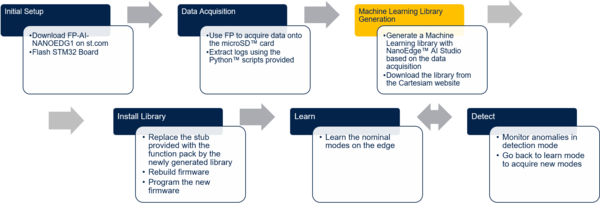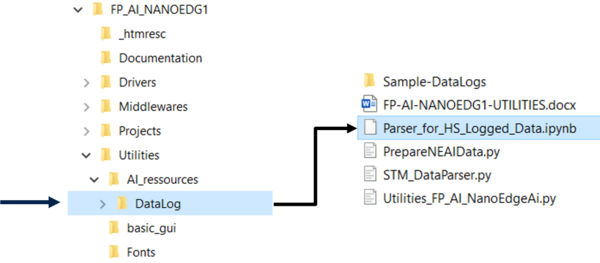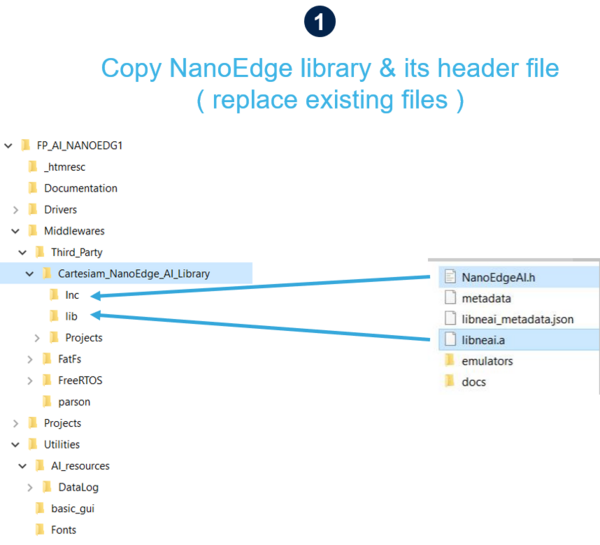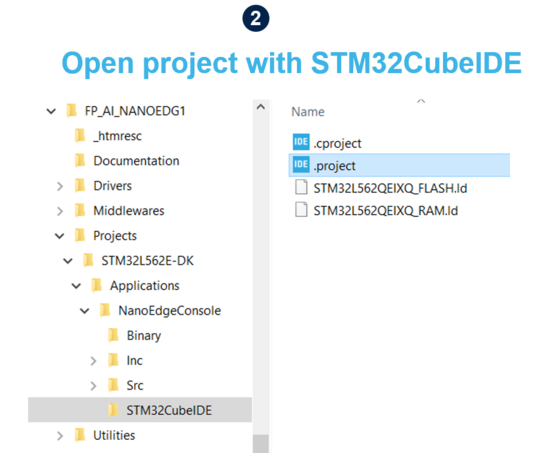| Delivery for this distribution is being prepared |
In this guide, you will learn how to get started using the Function Pack for Predictive Maintenance FP-AI-NanoEdg1 and use it as your first project to detect anomalies in your setup using accelerometer data.
This Function Pack supports two STM32 boards, STWIN and STM32L562E. Following the steps provided in this page, a user will be able to create the data logs for their setups, and generate EdgeAi libraries using Cartesiam NanoEdge AI Studio. Once these libraries are generated, the user can use these libraries by plugging them into the provided FP and can learn the nominal behavior of his setup by issuing commands through a command line interface (CLI). After training phase the monitoring can be started and any anomalies from the normal behavior are reported on the CLI as well as on the LCD (in case of L5 board).
1. What you will learn
- How to log the motion sensor data.
- How to parse and read the motion sensor data.
- How to generate the suitable libraries for your sample data set using Cartesiam NanoEdge AI Studio.
- Learn and detect the anomalies and controlling the hyper parameters of learning and detection.
2. Condition Monitoring using NanoEdge AI Machine Learning Library
This section provides complete method to set up an application for condition monitoring using FP-AI-NANOEDG1. The steps are provided with brief details in the diagram below.
The details on how to set up the sensor board with function pack as well as data collection have been already provided in the sections above. Following sections provide the details on library generation, installation, training and testing.
2.1. Generating a Condition Monitoring Library
The AI libraries for the condition monitoring for this function pack are generated and provided by NanoEdge AI Studio, a solution provided by Cartesiam. This section provides step by step guide on how to generate these condition monitoring libraries, installing them on the sensor node by linking them to the provided project in FP-AI-NANOEDG1 and then using them to perform the condition monitoring on the edge, by running first in training and then detection mode.
2.1.1. Data Logging for Normal and Abnormal Conditions
The library generation requires some sample data to be provided to the NanoEdge AI Studio. This data will provide the context of the set up to be monitored. The first step is to log the data for the normal and abnormal conditions using the data logging application provided in this function pack. Note that this data is to generate the libraries, so the users are advised to record data by exposing all the possible normal and any known abnormal conditions.
2.1.2. Data Preparation for Library Generation with NanoEdge AI Studio
The data logged through the datalogger is in the binary format and is not user readable in its current condition. In order to convert this data to useful form, FP-AI-NANOEDG1 provides python utility scripts. These scripts along with example usage can be found in a Parser_for_HS_Logged_Data.ipynb , a Python Jupyter Notebok, located on the path FP-AI-NANOEDG1/Utilities/AI-resources/DataLog/ as shown in the figure below.
2.1.3. Library Generation using NanoEdge AI Studio
The process of generating the libraries with Cartesiam NanoEdge AI studio consists of five steps.
- Hardware description
- Choosing a microcontroller type : ARM® Cortex® M33
- Maximum amount of RAM to be allocated for the library: Usually a few KBs will suffice (but it depends on the dataframe length used in the process of data preparation).
- Sensor type : 3-axes accelerometer
- Providing the sample contextual data to adjust and gauge the performance of the chosen model. This step will require data for:
- Nominal or Normal case
- Abnormal case
- Benchmarking of available models and choosing the one which complies with the requirements.
- Validating the model for learning and testing through the provided emulator which emulates the behavior of the library on the edge.
- The final step is to compile and download the libraries. In this process the flag mfloatabi has to be unchecked for using libraries with hardware FPU.
The detailed documentation on the NanoEdge AI Studio is available here NanoEdge AI Studio Documentation.
2.2. Installing the NanoEdgeAI Machine Learning Library
Once the libraries are generated and downloaded from Cartesiam NanoEdge AI Studio, the next step is to incorporate these libraries to FP-AI-NANOEDG1. The FP-AI-NANOEDG1, comes with the library stubs in the place of the actual libraries generated by NanoEdge AI studio. This is done in order to make it easy for users to link the generated libraries and have a place holder for the libraries which are generated through following the steps provided in the previous section. In order to link the actual libraries, the user needs to copy the generated libraries and replace the existing stub/dummy libraries and header files NanoEdgeAI.h, and libneai.a files present in the folders lib, and bin, respectively. The relative paths of these folders are /FP_AI_NANOEDG1/Middlewares/Third_Party/Cartesiam_NanoEdge_AI_Library/ as shown in the figure below.
Once these files copied, the project must be reconstructed and flashed on the sensor board in order to link the libraries. For this user needs to open the .project file from the FP-AI-NANOEDG1 folder, located at the path FP_AI_NANOEDG1/Projects/STM32L562E-DK/Applications/NanoEdgeConcole/STM32CubeIDE/ as shown in the step 2 in figure below.
To install the new firmware after linking the library, connect the sensor board and rebuild the project using the play button. See the console for the outputs and wait for the Build and Download success message as shown in step 4 in the figure below.
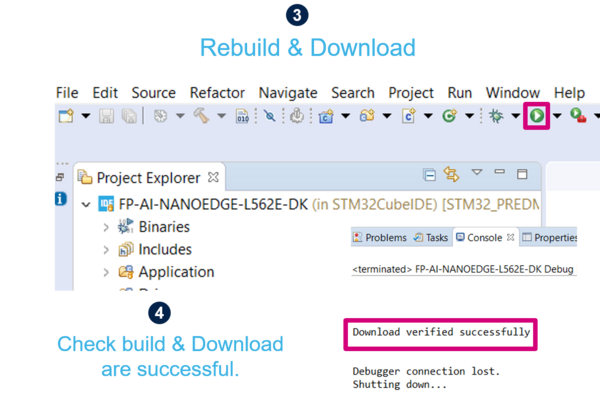
2.3. Testing the NanoEdgeAI Machine Learning Library
Once the Downoad verified successfully message appears, the generated AI libraries are linked to the firmware on the sensor board and are ready to test.
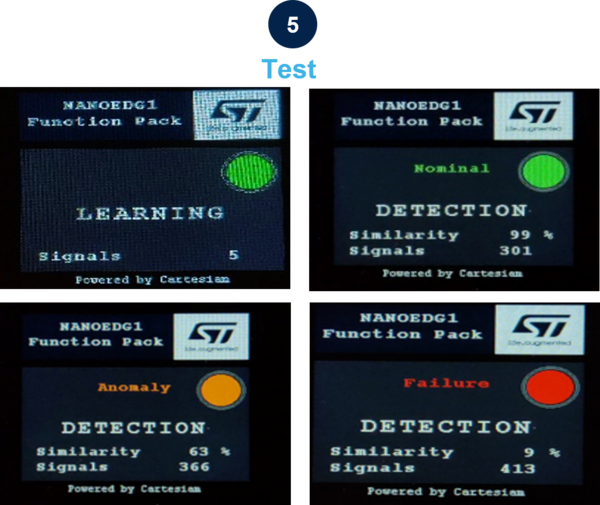
Note that in its current form the libraries have zero knowledge of the normal and abnormal conditions, and to perform the condition monitoring effectively, it is important to learn the normal behavior of the setup/machine to be modeled. This can be done by starting the learning process. The learning phase can be started by issuing start neai_learn command in console. Starting this command will show the process of learning and will show a message on the console every time learning is performed on a new signal, as shown in below code snippet.
$ start neai_learn NanoEdgeAI: starting $ 1 signal learning: SUCCESS. 2 signal learning: SUCCESS. 3 signal learning: SUCCESS. 4 signal learning: SUCCESS. 5 signal learning: SUCCESS. 6 signal learning: SUCCESS.
The process can be stopped either by issuing the
$ stop
command or by simply pressing the ESC key on the keyboard.
The alternate way to start the learning process is to long press the user button, as showed in the splash screen of the sensor node. This button can be used to start the learning in standalone as well as in computer operated mode. The process can be stopped by simply pressing the user button again.
Once the normal conditions are learned, the user can start the condition monitoring process by starting the neai_detect mode. This mode can be started by issuing the command
$ start neai_detect NanoEdgeAI: starting
or by short pressing the user button on the sensor board. The LCD will show the detection mode is activated along with the status through the LED in the screen, Green for Normal, Orange for Anomaly, and Red for Failure, as shown in the screen shots in figure above.
2.3.1. Some Hyper-parameters in Condition Monitoring
For the convenience of the users CLI also provides some handy options to run the inference and learning process of the condition monitoring easily. Users can see all the variables they can play with by issuing following command:
$ neai_get all NanoEdgeAI: signals = 0 NanoEdgeAI: sensitivity = 1.000000 NanoEdgeAI: threshold = 95 NanoEdgeAI: timer = 0
Each of the these parameters can be configured using neai_set <param> <val> command. The details are provided in the command table above.
This section provides small details on neai_set signals <nr of signals> . Using this command a user can start the learning or condition monitoring mode for a given number of samples. For example, if the user wants to learn on 100 signals, they can issue this command, before issuing the learn command. In the following snippet an example is presented where the learning is performed for 10 signals.
$ neai_set signals 10 NanoEdgeAI: signals set to 10 $ start neai_learn NanoEdgeAI: starting $ 1 signal learning: SUCCESS. 2 signal learning: SUCCESS. 3 signal learning: SUCCESS. 4 signal learning: SUCCESS. 5 signal learning: SUCCESS. 6 signal learning: SUCCESS. 7 signal learning: SUCCESS. 8 signal learning: SUCCESS. 9 signal learning: SUCCESS. 10 signal learning: SUCCESS. NanoEdge AI: stopped
The threshold parameter is used to report the anomalies. For any signal which has similarities below the threshold value is reported as anomaly. The default value used in the CLI application is 95. Users can change this value by using neai_set threshold <val> command.
The sensitivity parameter is used as an emphasis parameter. The default value is set to 1. Increasing this sensitivity will mean that the matching of the signals is to be performed more strictly, reducing it will also reduce the matching calculation process, i.e. resulting is higher matching values.
For details users are invited to read the detailed documentation of NanoEdge AI studio here.
